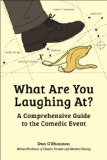new book – ‘What Are You Laughing At? A Comprehensive Guide to the Comedic Event’ by Dan O’Shannon
Written on July 21, 2012
What Are You Laughing At?: A Comprehensive Guide to the Comedic Event by Dan O’Shannon (Continuum, 2012)
Book description from the publisher:
If you’re looking for a book that will teach you how to write comedy, we suggest you keep moving. You still have time to pick up a copy of Writing Big Yucks for Big Bucks before the store closes. However, if you want to understand the bigger picture — what is comedy, why do we respond to it the way we do — then you’ve come to the right place.
What Are You Laughing At? presents an entirely new approach to comedy theory. It challenges long-held beliefs and shows how the three main theories of comedy (incongruity, superiority, and relief) are not in conflict; but rather, work as parts of a larger model. There are many examples pulled from the author’s own experiences, writing for shows such as Cheers, Frasier, and Modern Family. By the end, you’ll have an understanding of just what happens when man meets comedy. It will change the way you hear laughter.
Table of Contents
INTRODUCTION
OVERVIEW
Common Comedy Theories
The Comedic Event
Documenting the Comedic Event
PART I: ELEMENTS OF CONTEXT: THE RECEPTION FACTORS
CHAPTER 1: THE RECEIVER AND HIS WORLD
1-1. A Comedy Frame of Mind
1-2. Early Reception Factors
1-3. Levels of Social Interaction
CHAPTER 2: ELEMENTS OF COMMUNICATION
2-1. Modes of Communication
2-2. Device and Specific Device
CHAPTER 3: VEHICLES
3-1. Vehicles
3-2. Vehicle-based Reception Factors
CHAPTER 4: LEVEL OF CONTROL AND IDENTIFYING THE SOURCE
4-1. Level of Control
4-2. Identifying The Source
PART II: THE INCONGRUOUS PICTURE
CHAPTER 5: FUNDAMENTAL COMPONENTS
5-1. The Receiver’s Brain: Hard-wired for Comedy?
5-2. The Triangle
5-3. The Core Variables
CHAPTER 6: INCONGRUITY
6-1. Incongruity
6-2. Estimating Levels of Incongruity
6-3. Types of Incongruity
CHAPTER 7: COGNITIVE PROCESS
7-1. Cognitive Process: Overview
7-2. Level One: Straightforward Information
7-3. Level Two: Gap-filling
7-4: Level Three: Recontextualization
CHAPTER 8: VARIATIONS
8-1. Exploring the Four Corners of the Triangle
8-2. What are Practical Jokes?
CHAPTER 9: COMEDY AND ENTROPY
9-1. Sustaining the Laugh
9-2. Entropy
PART III: ENHANCERS AND INHIBITORS
CHAPTER 10: HOW COMEDIC INFORMATION TRIGGERS ENHANCERS AND INHIBITORS
10-1. Overview
10-2. On-going Social Needs: Superiority, Identification, and Inclusion
10-3. Aspects of Awareness
CHAPTER 11: ELEMENTS OF THE JOKE’S COMMUNICATION, STRUCTURE, AND CONTENT
11-1. Resuming the Chart: The Joke as a Whole
11-2. Elements of Communication and Structure
11-3. Elements of Content
SUMMING IT ALL UP
The Completed Chart
Final Thoughts and Acknowledgments
Filed in: fiction,new books,psychology.



